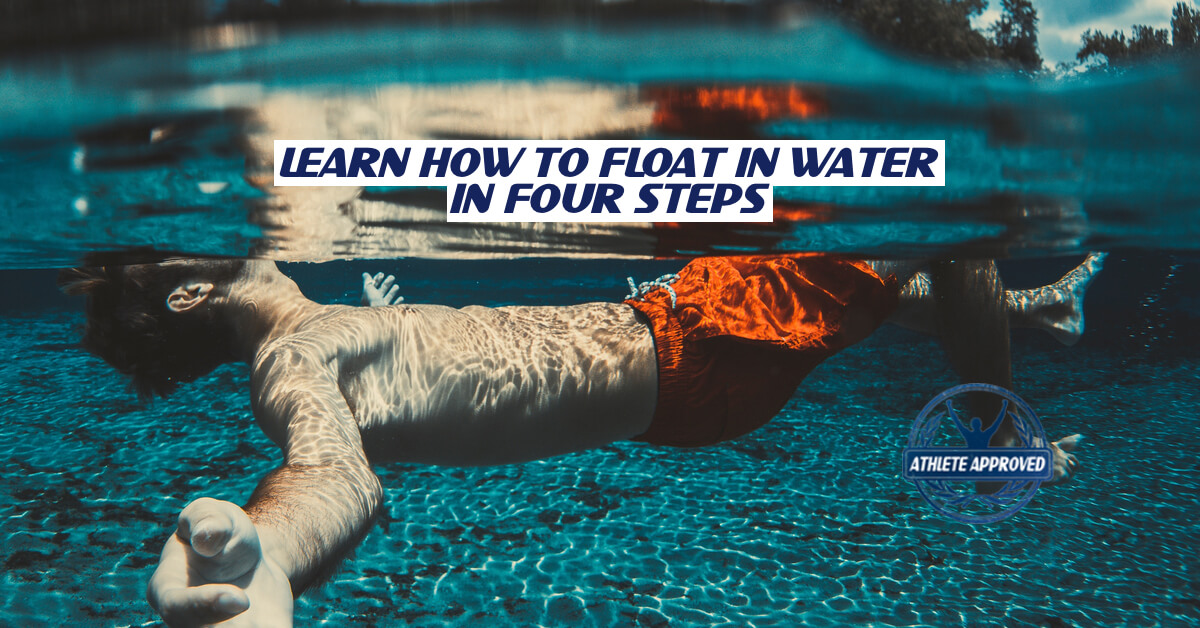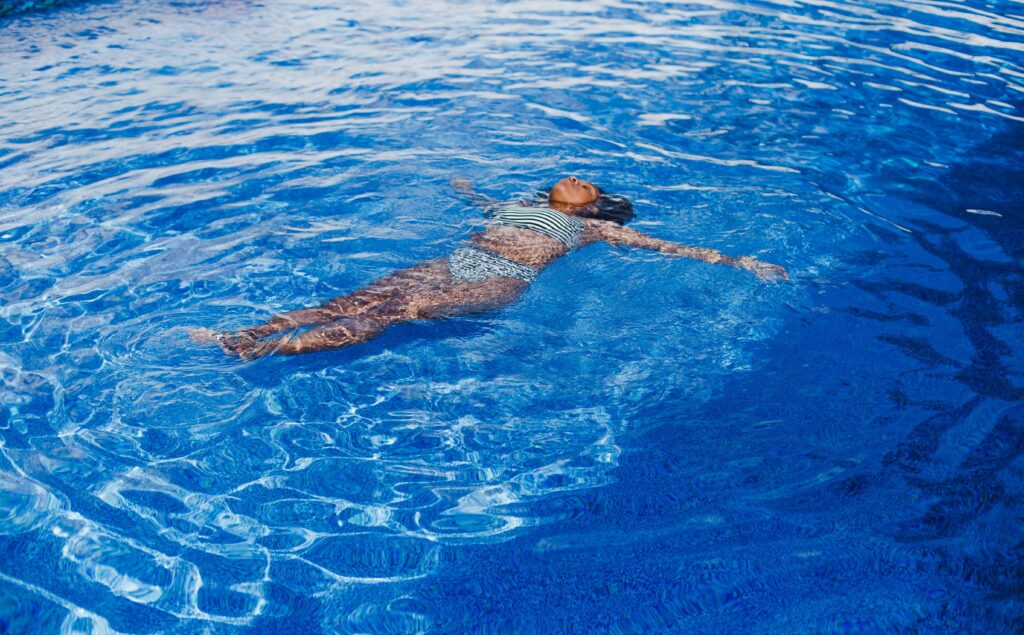
Athlete Approved is reader supported. If you make a purchase through our links, we earn an affiliate commission, at no extra cost to you. We highly recommend all products and only promote items that are Athlete Approved.
Learning how to float is the most important swim technique everyone should master. You will not swim efficiently without this skill.
When you float in water, you learn the basics on body position and controlling your breath. Floating is relaxing and meditative. And most importantly, it can save your life one day.
No matter your body type, everyone is able to float in water to some extent.
In this article, we teach step-by-step how to float in water like a pro.
Preparing To Float In Water
Before you can start floating in water, you need to get yourself prepared by learning in the right aquatic environment, having a helping hand, and utilizing certain pieces of swim equipment.
Be Comfortable In Your Aquatic Environment
The first step is to ensure you are comfortable in your aquatic environment.
You can do this by starting in the shallow end of a pool. Be sure to have the comfort of always being able to stand up if needed.
We also recommend staying next to the wall or lane line.
Once you have mastered floating in the shallow end, then you can start to move into the deeper areas of the pool.
Use A Spotter
While you are learning to float, make sure you have a spotter with you at all times for added safety.
A spotter can place a hand under your torso or head until you are comfortable lying forward or back in the water unassisted.
It is reassuring knowing someone is there to physically support you. And sometime just as importantly to morally support you!
Water can be dangerous, so be sure to always keep pool safety a top priority.
Get Help From Swim Equipment
Utilize swim equipment to help you learn how to float:
- Kickboard: You can stretch out on your front or back while holding it with two hands for support. Another good way to practice floating is to hug a kickboard on your back.
- Pull Buoy: Place it between your legs for extra buoyancy. Then remove it as you get more comfortable.
- Noodle: Similar to a pull buoy, but place it around the hips for added buoyancy and sense of safety.
- Snorkel: Using a snorkel will allow you to breath when floating on your front. This way you can get all the air you need while staying 100% focused on learning how to float.
- Nose Clip: This will prevent beginner swimmers from getting water in their nose. Once you get more advanced, you can exhale through your nose to prevent water from entering.
Mastering floating is all about being comfortable. Finding that perfect technique balance while relaxing is the sweat spot to aquatic bliss (and safety).
Method To Float In Water
Follow these four steps to learn how to float.
We recommend starting on your front with your face in the water. While you will not be able to freely breath (unless you are using a snorkel which his highly recommended), it is simpler for beginners to start this way. It is also easier to put your feet down and stand up if you are practicing on your front, compared to your back.
Step 1: Breathe as deeply in and out as you can. When you are ready, fully exhale, then take a big breath in and hold it. Caution: Never push your limits when it comes to breath holding. Ever.
Step 2: Put your face in the water and look straight down at the bottom of the pool. It can help to have a reference point to look for such as a pool tile or toy.
Step 3: Gently push off the bottom of the pool and begin to fall forward. Make sure that you keep looking down.
Step 4: Full extend your arms and legs. Ensure that your shoulders are rolled back, so that your chest is fully open. Keep your core engaged. This helps to keep your body on top the water. If you look forward, your legs will follow causing you to sink.
By following these tips, you should be floating on your front in no time!
Next, repeat the same steps to float on your back. The nice thing about floating on your back is that you can breath freely.
When you are on your back, focus on your breathing. It will help you remain calm and continue to float.
Take notice to how when you inhale and hold your breath in you float higher than when you exhale. Be sure to push that belly button up to the sky.
Floating In Water Tips
Floating is not only important for beginners, but advanced swimmers practice floating to perfect their body position. After years of perfecting our technique, here are some ways to help you float a lot more easily.
Floating Tip 1: Keep your head in a neutral position.
If you are on the front, that means straight down at the bottom of the pool. If you are on your back, then straight up at the sky.
It is common for people to want to look at their feet or chest to see what they are doing. This is a big no-no!
Even slightly moving your chin down towards your chest will throw your alignment off and make your entire body sink in the water.
Floating Tip 2: Some people find that after a few seconds of floating they need to move their feet a bit to avoid sinking. If you have found this issue, there is an easy way to solve it.
To counteract this, try to stretch your hands out, so they are above your head. This will counteract the weight of your legs.
And if you still have slight sinking action in your legs, that can be normal. It just means you are muscular!
Floating Tip 3: Control your breathing and take steady breaths. Your lungs can act like balloons while you are breathing. Therefore, you should try to take breaths from your diaphragm.
Those who have a greater lung capacity will be able to float more easily. This is due to them having a bigger pocket of air in their chest that allows them to rise up.
Also, as they have more oxygen circulating around their bodies, it is much less dense than water. Thus, this extra oxygen makes the person’s bodies much lighter and buoyant.
Why Do I Sink?
The reason objects float or sink in water comes down to one scientific term: Density.
Put simply, if an object is more dense than water, it will sink. If it is less dense than water, it will float.
Our bodies are made of things like muscle, fat, blood, and bones. On average, humans are close to the density of water, however, some bodies are more buoyant than others.
Human muscle sinks, while fat floats. Therefore, for someone with a higher muscle mass will find floating to be more difficult than someone with higher body fat.
You may also notice it is easier to float in the ocean. That is because of salt water. When salt dissolves into water, it makes the water more dense.
No matter your body shape, size, or type, we all have hope. It may take more practice, but everyone can learn how to float.
Conclusion
Learning to float is the first step to learning how to swim. Additionally, it is incredibly relaxing and is a skill that may even save your life.
Set yourself up for success by being in the right environment, using a spotter, and utilizing swim equipment.
Like anything worth learning: the more often you practice, the better you’ll become at it. Our four step guide will have you floating like a pro in no time.
*Equip yourself for success with our Athlete Approved Guide to Lap Swimming Equipment!*


No comment yet, add your voice below!